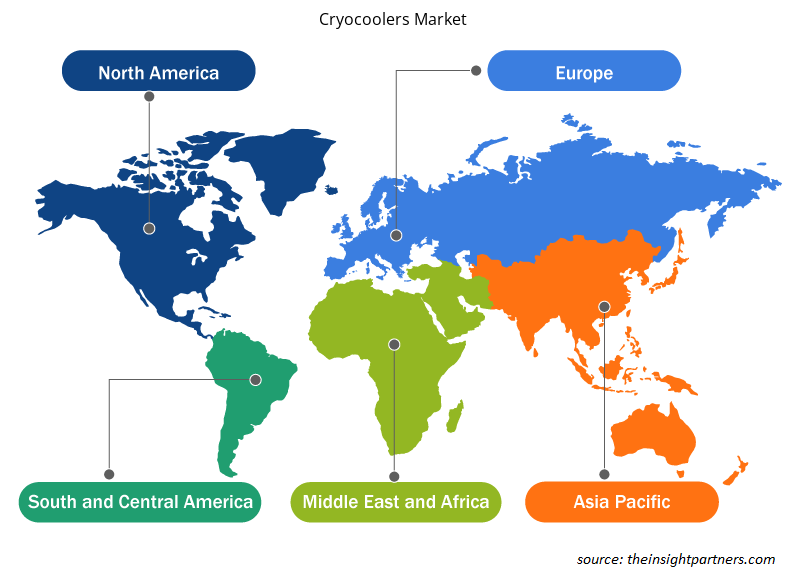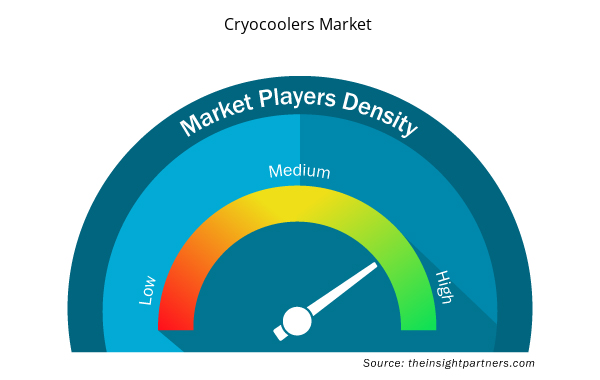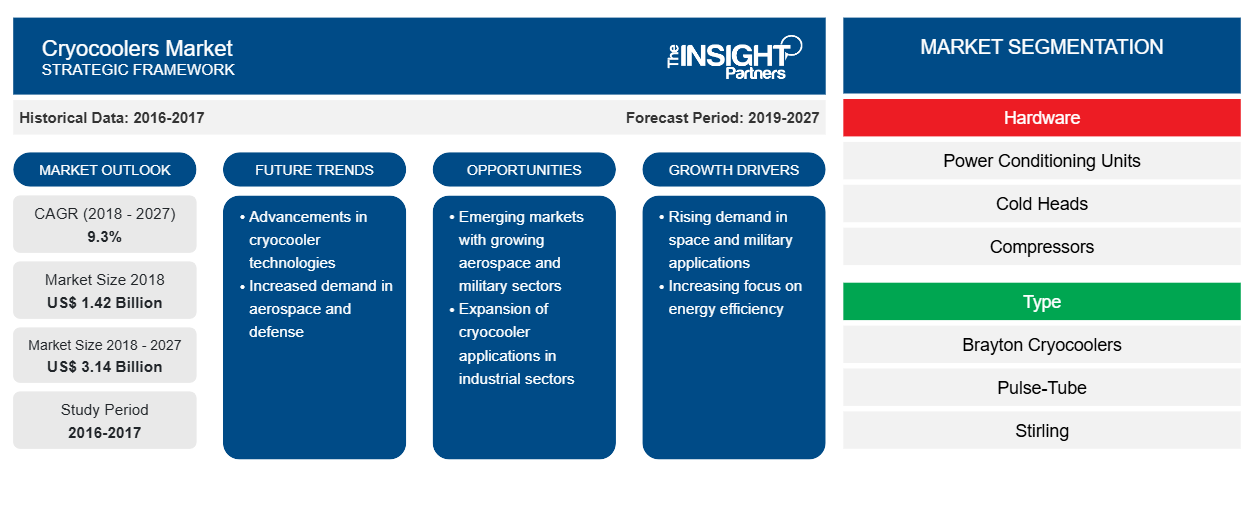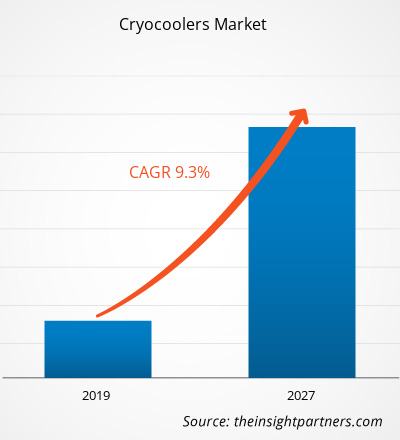2018 年低温冷却器市场规模为 14.1552 亿美元,预计在 2019 年至 2027 年的预测期内,复合年增长率为 9.3%,到 2027 年将达到 31.3717 亿美元。
预计亚太地区将成为增长最快的市场,而北美将成为整个预测期内收入最高的市场。对低温冷却器应用的更高投资(例如医疗保健和太空应用数量的增加)将加剧北美低温冷却器市场的增长。此外,亚洲国家的军事支出较高,其中包括用于军事外太空计划的高额预算。2018 年亚太地区的整体军事支出超过 4500 亿美元,预计将推动该地区低温冷却器市场的发展。
市场洞察
太空应用中低温解决方案的采用
低温恒温器主要使用低温流体,例如液氦、液氮或冷氮和氦气。然而,提取这些低温液体进行被动冷却的成本较高,这导致了对替代材料的寻找。低温冷却器早在三十多年前就已投入商业使用,在成本效益、可靠性和较低维护成本方面可作为低温液体的替代品。低温冷却器的突出特点是尺寸更小、重量更轻、体积更小,尤其是在太空应用中,这使它们成为独一无二的产品。
定制此报告以满足您的需求
您可以免费定制任何报告,包括本报告的部分内容、国家级分析、Excel 数据包,以及为初创企业和大学提供优惠和折扣
- 获取此报告的关键市场趋势。这个免费样品将包括数据分析,从市场趋势到估计和预测。
高效低温冷却器的出现
预计心血管成像中新兴的诊断程序以及涉及图像引导手术的治疗程序将同时产生对比目前“开槽”磁体中更高的磁场和比目前“短孔”磁体中更大的患者接触范围的需求。这些目标与持续降低磁体价格的预期需求不一致。低温制冷的持续进步将导致 HTS 导体的成本目标不断变化,而且它们是否会应用于需要大量导体的空芯 MRI 磁体绕组是值得怀疑的,因为它们的成本比 LTS 导体高得多。
产品洞察
全球低温冷却器市场按类型划分,由 Gifford-McMahon (GM) 部门主导。低温冷却器市场中考虑的其他产品包括 Brayton 低温冷却器、脉冲管 (PT)、斯特林、焦耳-汤姆森 (JT) 等。
应用程序洞察
低温冷却器市场按应用细分为环境、运输、军事、商业、医疗保健、空间、研发、农业等。低温冷却器调节、阻断和允许任何介质(如液体、气体和水)通过管道流动。服务业和 IT 行业的兴起导致过去几年商业建筑数量急剧增长。除此之外,政府对保持这些建筑的能源效率实施了严格的规定,导致越来越多地采用优化能源消耗的产品。
新的市场举措被视为全球低温冷却器行业最常采用的战略。以下列出了一些最近的市场举措:
2019 年:SHI Cryogenics Group 推出了 RDE-418D4 1.8/2.0W 4K 低温冷却器,为其 Gifford-McMahon (GM) 低温冷却器系列添加了新型号。与现有型号相比,这款新型 RDE-418D4 低温冷却器将冷却性能提高了 20%。2018
年:Chart Industries, Inc. 宣布已完成将其生物医学部门内的氧气相关产品业务(“CAIRE Medical”)以 1.335 亿美元的价格出售给 NGK SPARK PLUG CO., LTD.。剥离氧气相关产品业务的战略决策反映了 Chart 的战略和资本配置方法,即专注于其核心低温能力和产品。2018
年:Chart Industries Inc. 收购了 Skaff Cryogenics & Cryo-Lease, LLC。收购 Skaff 扩大了 Chart 在美国东北部直接提供服务和售后支持的区域影响力。这是该公司为客户创造更多价值而采取的一项极具战略意义的扩张行动。
低温冷却器市场区域洞察
Insight Partners 的分析师已详尽解释了预测期内影响低温冷却器市场的区域趋势和因素。本节还讨论了北美、欧洲、亚太地区、中东和非洲以及南美和中美洲的低温冷却器市场细分和地理位置。

- 获取低温冷却器市场的区域特定数据
低温冷却器市场报告范围
| 报告属性 | 细节 |
|---|---|
| 2018 年市场规模 | 14.2亿美元 |
| 2027 年市场规模 | 31.4亿美元 |
| 全球复合年增长率(2018 - 2027) | 9.3% |
| 史料 | 2016-2017 |
| 预测期 | 2019-2027 |
| 涵盖的领域 | 通过硬件
|
| 覆盖地区和国家 | 北美
|
| 市场领导者和主要公司简介 |
|
低温冷却器市场参与者密度:了解其对业务动态的影响
低温冷却器市场正在快速增长,这得益于终端用户需求的不断增长,而这些需求又源于消费者偏好的不断变化、技术进步以及对产品优势的认识不断提高等因素。随着需求的增加,企业正在扩大其产品范围,进行创新以满足消费者需求,并利用新兴趋势,从而进一步推动市场增长。
市场参与者密度是指在特定市场或行业内运营的企业或公司的分布情况。它表明在给定市场空间中,相对于其规模或总市场价值,有多少竞争对手(市场参与者)存在。
在低温冷却器市场运营的主要公司有:
- 先进研究系统公司
- 布鲁克斯自动化公司
- Chart 工业公司
- Cryomech 公司
- 诺斯罗普·格鲁曼公司
免责声明:上面列出的公司没有按照任何特定顺序排列。

- 获取低温冷却器市场顶级关键参与者概览
全球低温冷却器——市场细分
全球低温冷却器市场 - 按硬件划分
- 电源调节装置
- 冷头
- 压缩机
- 散热管
- 其他的
全球低温冷却器市场 - 按类型
- 布雷顿低温冷却器
- 脉冲管(PT)
- 斯特灵
- 吉福德-麦克马洪
- 焦耳-汤姆逊 (JT)
- 其他的
全球低温冷却器市场 - 按应用划分
- 卫生保健
- 环境的
- 运输
- 军队
- 商业的
- 空间
- 研究与开发
- 农业
- 其他的
全球低温冷却器市场-按地区划分
北美
- 我们
- 加拿大
- 墨西哥
欧洲
- 法国
- 德国
- 意大利
- 西班牙
- 英国
- 欧洲其他地区
亚太地区 (APAC)
- 台湾
- 中国
- 印度
- 澳大利亚
- 日本
- 亚太其他地区
中东和非洲 (MEA)
- 沙特阿拉伯
- 阿联酋
- 南非
- MEA 其他地区
南美洲 (SAM)
- 巴西
- 阿根廷
- SAM 其余部分
全球低温冷却器市场 - 公司简介
- 先进研究系统公司
- 布鲁克斯自动化公司
- Chart 工业公司
- Cryomech 公司
- 诺斯罗普·格鲁曼公司
- RICOR – 低温和真空系统
- 住友重工业株式会社
- Sunpower 公司 (Ametek 公司)
- 超导技术公司
- 泰雷兹集团
- 历史分析(2 年)、基准年、预测(7 年)及复合年增长率
- PEST 和 SWOT 分析
- 市场规模价值/数量 - 全球、区域、国家
- 行业和竞争格局
- Excel 数据集



Report Coverage
Revenue forecast, Company Analysis, Industry landscape, Growth factors, and Trends

Segment Covered
This text is related
to segments covered.

Regional Scope
North America, Europe, Asia Pacific, Middle East & Africa, South & Central America

Country Scope
This text is related
to country scope.
Trends and growth analysis reports related to Electronics and Semiconductor : READ MORE..
The List of Companies
- Advanced Research Systems, Inc.
- Brooks Automation Inc.
- Chart Industries Inc.
- Cryomech Inc.
- Northrop Grumman Corporation
- RICOR – Cryogenic & Vacuum Systems
- Sumitomo Heavy Industries, Ltd.
- Sunpower Inc. (Ametek Inc.)
- Superconductor Technologies Inc.
- Thales Group
The Insight Partners performs research in 4 major stages: Data Collection & Secondary Research, Primary Research, Data Analysis and Data Triangulation & Final Review.
- Data Collection and Secondary Research:
As a market research and consulting firm operating from a decade, we have published and advised several client across the globe. First step for any study will start with an assessment of currently available data and insights from existing reports. Further, historical and current market information is collected from Investor Presentations, Annual Reports, SEC Filings, etc., and other information related to company’s performance and market positioning are gathered from Paid Databases (Factiva, Hoovers, and Reuters) and various other publications available in public domain.
Several associations trade associates, technical forums, institutes, societies and organization are accessed to gain technical as well as market related insights through their publications such as research papers, blogs and press releases related to the studies are referred to get cues about the market. Further, white papers, journals, magazines, and other news articles published in last 3 years are scrutinized and analyzed to understand the current market trends.
- Primary Research:
The primarily interview analysis comprise of data obtained from industry participants interview and answers to survey questions gathered by in-house primary team.
For primary research, interviews are conducted with industry experts/CEOs/Marketing Managers/VPs/Subject Matter Experts from both demand and supply side to get a 360-degree view of the market. The primary team conducts several interviews based on the complexity of the markets to understand the various market trends and dynamics which makes research more credible and precise.
A typical research interview fulfils the following functions:
- Provides first-hand information on the market size, market trends, growth trends, competitive landscape, and outlook
- Validates and strengthens in-house secondary research findings
- Develops the analysis team’s expertise and market understanding
Primary research involves email interactions and telephone interviews for each market, category, segment, and sub-segment across geographies. The participants who typically take part in such a process include, but are not limited to:
- Industry participants: VPs, business development managers, market intelligence managers and national sales managers
- Outside experts: Valuation experts, research analysts and key opinion leaders specializing in the electronics and semiconductor industry.
Below is the breakup of our primary respondents by company, designation, and region:

Once we receive the confirmation from primary research sources or primary respondents, we finalize the base year market estimation and forecast the data as per the macroeconomic and microeconomic factors assessed during data collection.
- Data Analysis:
Once data is validated through both secondary as well as primary respondents, we finalize the market estimations by hypothesis formulation and factor analysis at regional and country level.
- Macro-Economic Factor Analysis:
We analyse macroeconomic indicators such the gross domestic product (GDP), increase in the demand for goods and services across industries, technological advancement, regional economic growth, governmental policies, the influence of COVID-19, PEST analysis, and other aspects. This analysis aids in setting benchmarks for various nations/regions and approximating market splits. Additionally, the general trend of the aforementioned components aid in determining the market's development possibilities.
- Country Level Data:
Various factors that are especially aligned to the country are taken into account to determine the market size for a certain area and country, including the presence of vendors, such as headquarters and offices, the country's GDP, demand patterns, and industry growth. To comprehend the market dynamics for the nation, a number of growth variables, inhibitors, application areas, and current market trends are researched. The aforementioned elements aid in determining the country's overall market's growth potential.
- Company Profile:
The “Table of Contents” is formulated by listing and analyzing more than 25 - 30 companies operating in the market ecosystem across geographies. However, we profile only 10 companies as a standard practice in our syndicate reports. These 10 companies comprise leading, emerging, and regional players. Nonetheless, our analysis is not restricted to the 10 listed companies, we also analyze other companies present in the market to develop a holistic view and understand the prevailing trends. The “Company Profiles” section in the report covers key facts, business description, products & services, financial information, SWOT analysis, and key developments. The financial information presented is extracted from the annual reports and official documents of the publicly listed companies. Upon collecting the information for the sections of respective companies, we verify them via various primary sources and then compile the data in respective company profiles. The company level information helps us in deriving the base number as well as in forecasting the market size.
- Developing Base Number:
Aggregation of sales statistics (2020-2022) and macro-economic factor, and other secondary and primary research insights are utilized to arrive at base number and related market shares for 2022. The data gaps are identified in this step and relevant market data is analyzed, collected from paid primary interviews or databases. On finalizing the base year market size, forecasts are developed on the basis of macro-economic, industry and market growth factors and company level analysis.
- Data Triangulation and Final Review:
The market findings and base year market size calculations are validated from supply as well as demand side. Demand side validations are based on macro-economic factor analysis and benchmarks for respective regions and countries. In case of supply side validations, revenues of major companies are estimated (in case not available) based on industry benchmark, approximate number of employees, product portfolio, and primary interviews revenues are gathered. Further revenue from target product/service segment is assessed to avoid overshooting of market statistics. In case of heavy deviations between supply and demand side values, all thes steps are repeated to achieve synchronization.
We follow an iterative model, wherein we share our research findings with Subject Matter Experts (SME’s) and Key Opinion Leaders (KOLs) until consensus view of the market is not formulated – this model negates any drastic deviation in the opinions of experts. Only validated and universally acceptable research findings are quoted in our reports.
We have important check points that we use to validate our research findings – which we call – data triangulation, where we validate the information, we generate from secondary sources with primary interviews and then we re-validate with our internal data bases and Subject matter experts. This comprehensive model enables us to deliver high quality, reliable data in shortest possible time.


 获取此报告的免费样本
获取此报告的免费样本